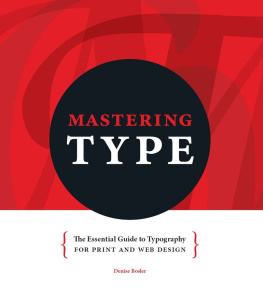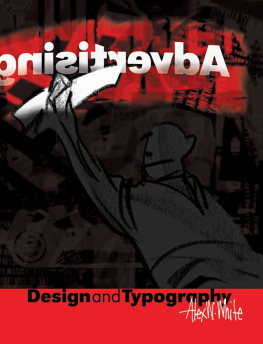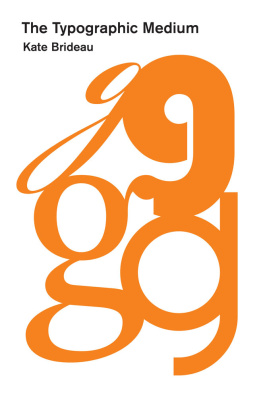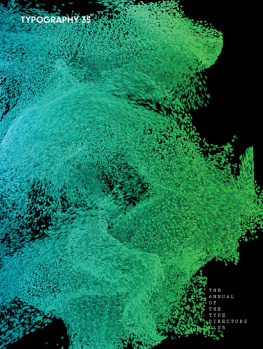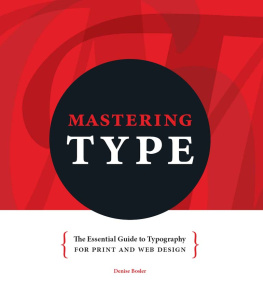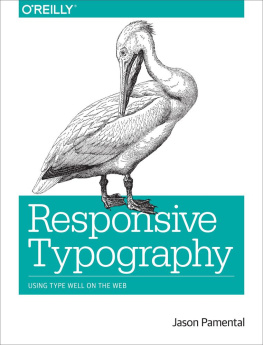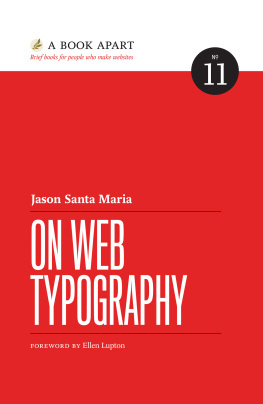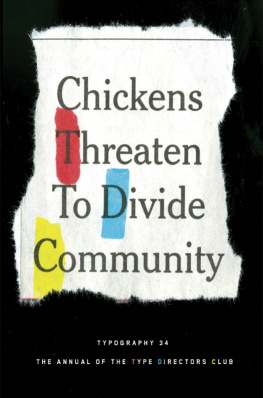Communications technology permeates our society. Look around. Typography is everywhere. Commuting to work, grocery shopping, surfing the Web or navigating a smartphone, we are bombarded by words of every shape, size and arrangement. It is essential for designers to understand the basics of typography to get an effective message across instantly. The goal of this book is to guide the reader in building a solid foundation of timeless typographic knowledge, for both print and digital media, while transcending transient technologies.
Regardless of the ever-advancing technology at our fingertips, we still rely on the same twenty-six letters. Typographic basics start with the principles we all learned as children: Letters form words, words form sentences, and sentences form paragraphs. The designers goal of optimizing communication via legibility, connotation and form are as fundamental as the alphabet. Does this mean we cant use technology to enhance our words? Certainly not. Typography is an art and can be treated as suchbut only after the basics are thoroughly understood and ingrained in the mind of the designer.
This book breaks down the study of type into a systematic progression of typographic relationshipsletters, words, sentences, paragraphs, pages and screenthrough content, examples, interviews and real-world inspiration. It illustrates to the beginning designer how professional type treatment looks, feels and reads. Careful study of these step-by-step details provides a virtual apprenticeship in typography, a valuable education for any designer.
chapter one
HISTORY
Confucius said, Study the past if you would divine the future. The past shows us where we came from and how we got to where we are today. In typography, many modern-day designs show the influence of the past. We must look to original forms of letters, how they were created and how they were used, to understand typographys full potential. This understanding will help guide us in making the best typographic choices for the future.
IN THE BEGINNING THERE WAS COMMUNICATION
Cave paintings are the first recognized form of human communication (). Found all over the world, symbols painted on walls and carved in rock represent primitive means of recording information. These pictographsimages that represent their literal meaningswere easily comprehended by the non-literate culture that created them. Pictographs work well for materials that need to communicate to speakers of a variety of languages. Contemporary pictographs are most commonly found on directional signage such as traffic indicators and public toilets.
Ancient Egyptians utilized pictographs in their hieroglyphics, although their language took the idea of using pictures one step further (). Phonogramsimages that represent soundswere also incorporated into their writings. This language allowed the Egyptians to communicate both concrete things and abstract concepts. Because the Egyptian language used both pictographs and phonograms, though, it was undecipherable to early discoverers of the beautiful murals and carvings depicting Egyptian history. It wasnt until 1799 that Pierre-Franois-Xavier Bouchard, a French captain, discovered the Rosetta Stone. This stone was the key to unlocking the until-then uninterpretable languages of the Egyptians. The Rosetta Stone had the exact same text carved in hieroglyphics, plus the demotic and Greek alphabets. This allowed scholars familiar with the Greek alphabet to decipher Egypts past.
Around the same time ancient Egyptians were creating hieroglyphics on walls and in stone, the Sumerians in Mesopotamia were writing on clay tablets. The Sumerians written language was called cuneiform, symbols that were pressed into clay with a wedge-shaped stylus (). Cuneiform used both phonograms and ideograms, sometimes using the same symbols for both. Ideograms are symbols or a combination of symbols that represent a concept. A modern-day example of this would be an image of a man holding a broom to represent the verb sweep, instead of meaning literally a man holding a broom. Reading cuneiform was not easy, as it required knowledge of both ideograms and phonograms, plus the ability to differentiate when a symbol was part of an ideogram and when it represented a sound.

1,500-year-old cave painting in the Cederberg region of south Africa

Egyptian hieroglyphics.
BIRTH OF THE MODERN WRITTEN LANGUAGE
During the fifteenth century B.C.E. , the Phoenicians developed an alphabet that consisted of twenty-two characters, all consonants (). The Phoenicians were the first to combine these characters to spell words, writing right to left. This alphabet spread throughout the Mediterranean region because of extensive trading. This writing system became the precursor to the Greek, Latin, Arabic and Hebrew alphabets.
Around the eighth century B.C.E. , the Greeks incorporated the Phoenician alphabet into their own language by adding vowels, dropping a few consonants and adding others; this brought the total number of letters to twenty-four (). The Greeks also began writing left to right. Spreading quickly, this alphabet became key to recording history. In fact, many texts from the Bible were written in Greek.

Cuneiform on a baked clay tablet.
The Roman alphabet evolved from the Greek alphabet (). Also called Latin, it is widely recognized as todays modern Western written language. Originally made up of twenty-three letters, the alphabet consisted of square capitals that were the Romans formal writing system; it had no lowercase letters. Used mainly for carving inscriptions in marble and stone, these letters were the forerunners of modern-day serif typefaces. The Romans also used rustic capitals, a less formal alphabet used primarily for text written with a pen. Both forms are recognizable as letterforms that make up the Western alphabet.

Phoenician alphabet.

Greek text in the Celcus Library, Ephesus, Izmir.

Roman text engraved in marble of the Santa Cecilia church, Rome.

A sheet of papyrus.


